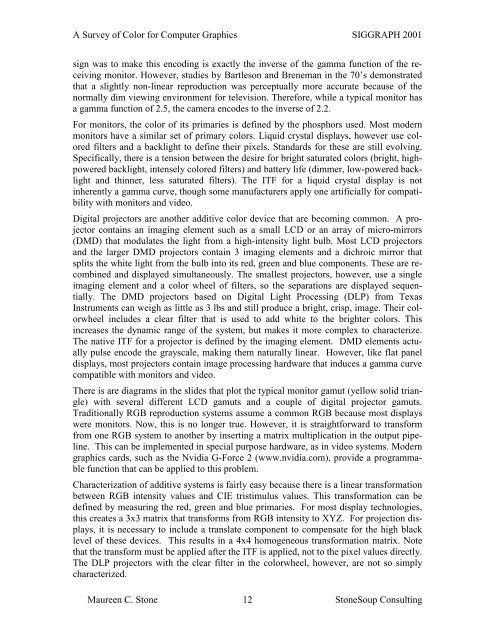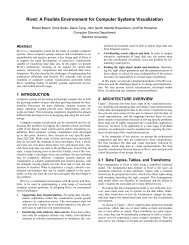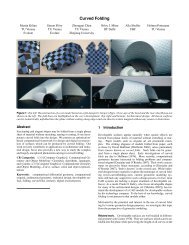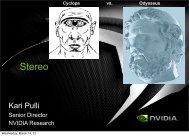A Survey of Color for Computer Graphics
A Survey of Color for Computer Graphics
A Survey of Color for Computer Graphics
Create successful ePaper yourself
Turn your PDF publications into a flip-book with our unique Google optimized e-Paper software.
A <strong>Survey</strong> <strong>of</strong> <strong>Color</strong> <strong>for</strong> <strong>Computer</strong> <strong>Graphics</strong> SIGGRAPH 2001<br />
sign was to make this encoding is exactly the inverse <strong>of</strong> the gamma function <strong>of</strong> the receiving<br />
monitor. However, studies by Bartleson and Breneman in the 70’s demonstrated<br />
that a slightly non-linear reproduction was perceptually more accurate because <strong>of</strong> the<br />
normally dim viewing environment <strong>for</strong> television. There<strong>for</strong>e, while a typical monitor has<br />
a gamma function <strong>of</strong> 2.5, the camera encodes to the inverse <strong>of</strong> 2.2.<br />
For monitors, the color <strong>of</strong> its primaries is defined by the phosphors used. Most modern<br />
monitors have a similar set <strong>of</strong> primary colors. Liquid crystal displays, however use colored<br />
filters and a backlight to define their pixels. Standards <strong>for</strong> these are still evolving.<br />
Specifically, there is a tension between the desire <strong>for</strong> bright saturated colors (bright, highpowered<br />
backlight, intensely colored filters) and battery life (dimmer, low-powered backlight<br />
and thinner, less saturated filters). The ITF <strong>for</strong> a liquid crystal display is not<br />
inherently a gamma curve, though some manufacturers apply one artificially <strong>for</strong> compatibility<br />
with monitors and video.<br />
Digital projectors are another additive color device that are becoming common. A projector<br />
contains an imaging element such as a small LCD or an array <strong>of</strong> micro-mirrors<br />
(DMD) that modulates the light from a high-intensity light bulb. Most LCD projectors<br />
and the larger DMD projectors contain 3 imaging elements and a dichroic mirror that<br />
splits the white light from the bulb into its red, green and blue components. These are recombined<br />
and displayed simultaneously. The smallest projectors, however, use a single<br />
imaging element and a color wheel <strong>of</strong> filters, so the separations are displayed sequentially.<br />
The DMD projectors based on Digital Light Processing (DLP) from Texas<br />
Instruments can weigh as little as 3 lbs and still produce a bright, crisp, image. Their colorwheel<br />
includes a clear filter that is used to add white to the brighter colors. This<br />
increases the dynamic range <strong>of</strong> the system, but makes it more complex to characterize.<br />
The native ITF <strong>for</strong> a projector is defined by the imaging element. DMD elements actually<br />
pulse encode the grayscale, making them naturally linear. However, like flat panel<br />
displays, most projectors contain image processing hardware that induces a gamma curve<br />
compatible with monitors and video.<br />
There is are diagrams in the slides that plot the typical monitor gamut (yellow solid triangle)<br />
with several different LCD gamuts and a couple <strong>of</strong> digital projector gamuts.<br />
Traditionally RGB reproduction systems assume a common RGB because most displays<br />
were monitors. Now, this is no longer true. However, it is straight<strong>for</strong>ward to trans<strong>for</strong>m<br />
from one RGB system to another by inserting a matrix multiplication in the output pipeline.<br />
This can be implemented in special purpose hardware, as in video systems. Modern<br />
graphics cards, such as the Nvidia G-Force 2 (www.nvidia.com), provide a programmable<br />
function that can be applied to this problem.<br />
Characterization <strong>of</strong> additive systems is fairly easy because there is a linear trans<strong>for</strong>mation<br />
between RGB intensity values and CIE tristimulus values. This trans<strong>for</strong>mation can be<br />
defined by measuring the red, green and blue primaries. For most display technologies,<br />
this creates a 3x3 matrix that trans<strong>for</strong>ms from RGB intensity to XYZ. For projection displays,<br />
it is necessary to include a translate component to compensate <strong>for</strong> the high black<br />
level <strong>of</strong> these devices. This results in a 4x4 homogeneous trans<strong>for</strong>mation matrix. Note<br />
that the trans<strong>for</strong>m must be applied after the ITF is applied, not to the pixel values directly.<br />
The DLP projectors with the clear filter in the colorwheel, however, are not so simply<br />
characterized.<br />
Maureen C. Stone 12<br />
StoneSoup Consulting















